|
 |
THE
NORTH NOVA SCOTIA HIGHLANDERS
|
 |
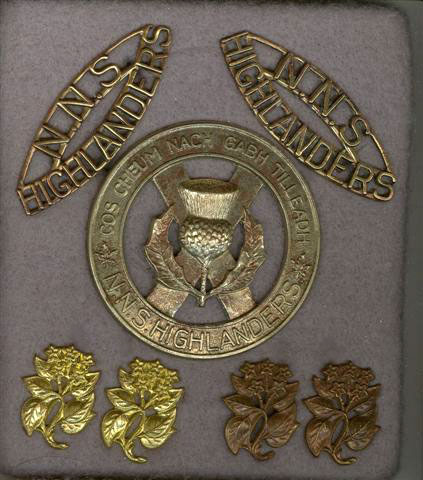
Cap Badge, Shoulder Titles and Collar badges
of the North Nova Scotia Highlanders
(Credit for photographs of the badges goes to Clifford Weirmeir, with his splendid website about
the Irish
regiment of Canada)
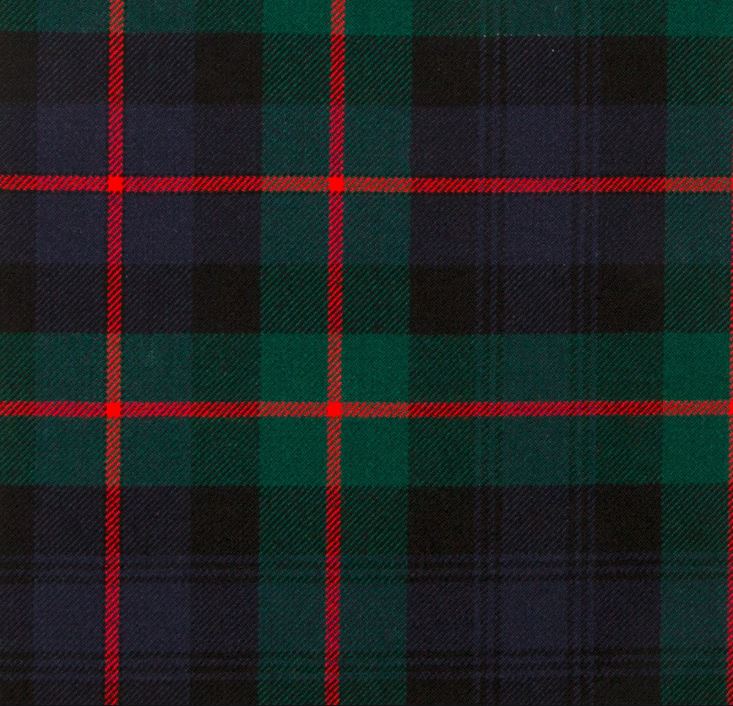
The Murray of Atholl Tartan of the North Nova Scotia Highlanders
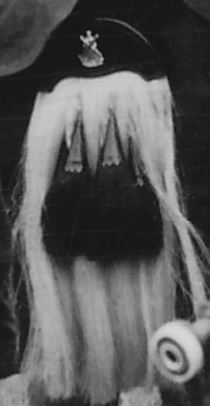
This was what the
sporran of the North Nova Scotia Highlanders' Pipe Band looked like.

This is "No
Retreating Footsteps", the regimental history of the North Nova's by
Will R. Bird
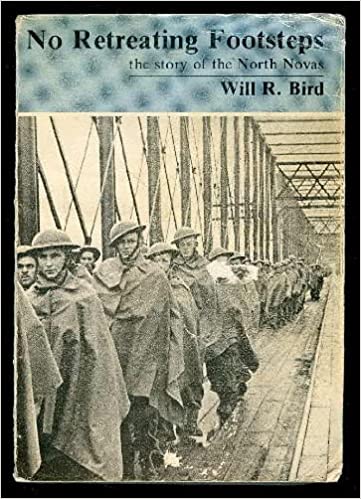
And this
is what the paperback edition looked like

The North Nova
Scotia Highlanders Pipe Band, ca. 1941.
source:
www.capebretonmilitaryhistory.com
Courtesy of Heather Almon, Sydney, NS, 2015, Ref.
Number: 15-10 (6.2)
This photograph was taken between 1940 and 1941, before the battalion
went overseas.
On the far left is Pipe Major Ross Stone of Truro, N.S. Third from the
left is Piper Alex Ingram of Stellarton, N.S. Eighth from the left is
Piper Duncan MacIntyre of French Road, Cape Breton,
and later Amherst, NS. Also in the photo (as noted in a war time
newspaper clipping) are Pipers Cecil Archibald of Kemptown; Alex Cooper
and Ralph Boston of Truro; Davie Matheson of Stellarton;
Ira C. MacPhee of Truro; and Frank Carrigan.
Drummers are Frank Carrigan Jr., Melville Blackmoore and Ben Mitton, all
of Truro.
Note that not all men have been issued North Nova Scotia Highlanders cap
badges yet.
At least two men have no cap badges at all, and the man to Pipe Major
Stone’s left, in the front row, has what appears to be a
Pictou Highlanders cap
badge.
During the preparations for the D-Day Invasion, the
North Nova's received the new higher shafted black leather "Third
Division Boots" and the newer MK III "Turtle Helmets".



Photographs L to R: MK I Helmet with N.N.S. decal,
Close-up of the Decal and Turtle Helmet with the N.N.S. Badge.
Source of helmet on the right:
https://canadaatwar.weebly.com/helmets.html
In Holland, Baarn 1945, at the
British 49th. Infantry Division "Victory
Variety" show.
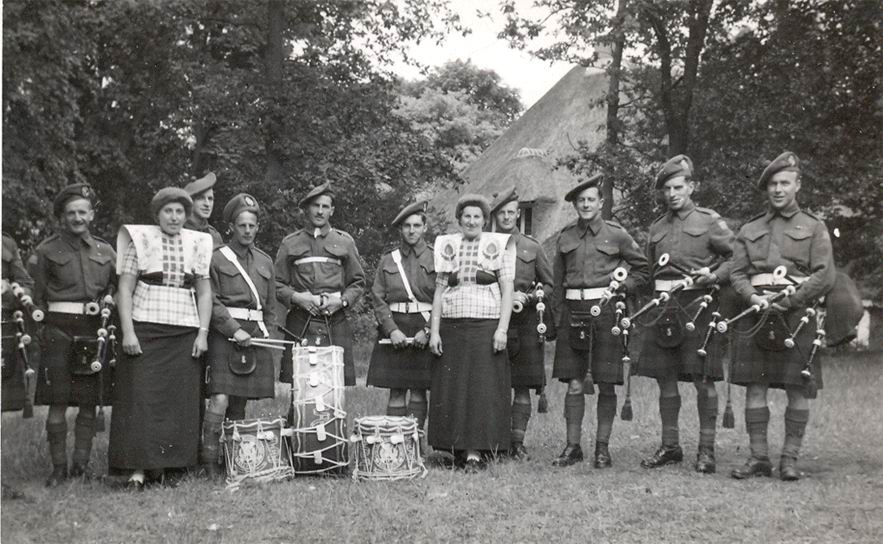
L to R: P.M.Ross Stone-Donald
Cooper-(lady 1)-Joe
Beaton-Peter Dominique-Russel Yorston-C.C. Cottenden-(lady 2)-Harry MacLellan-Hugh MacIntyre-?x?-Robert MacBeth
Piper Robert MacBeth
(also see his photograph from
1992 below) in his correspondence sent us a photograph very much like this, but this
time of the full band and he gave us
all the names of the members of the North NovaScotia
Highlanders pipe band on it (Look further
on, below
here).
About the above photograph he said: “that is me on
the extreme right; best looking chap?”
In the first letter (of
Nov 20/1990)
Robert MacBeth wrote to us:
- I myself
was piper with the North Nova’s, only 2 of us left now. If there
is anything I could help you with, do not hesitate to drop a
letter, maybe I will know, maybe not. So far my memory is OK. I
was over on the veteran trip to Holland in the spring, stayed at
a farm near Almelo, was at the big day in Apeldoorn. Had a great
trip, unbelievable.
-
I had a
visit from Grant Muir this summer, first time since the war had
seen him, he lives about 1500 miles from me. Had a wonderful 1˝
- 2 hrs. talk about the other days – better in 1 way – hell of a
lot worse in others. He is now a retired Presbyterian Minister.
He became chaplain of the 48th Highlanders after the
war, I think he said 10 years. We are the last 2 of all the
pipers!
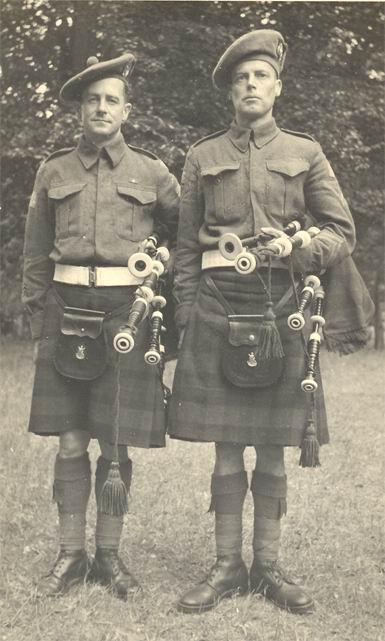
Left to right:
Piper Hugh MacIntyre and Pipe Corporal Duncan MacIntyre (no relation).
About the photograph immediately above here, In
the letter (of
Nov 20/1990)
Robert MacBeth wrote to us:
-
Now the photographs from Baarn, I don’t recall them being
taken, but I am there proud as a peacock. The two single men are
Hugh MacIntyre and Duncan MacIntyre. Both from the island of
Cape Breton.. Duncan was our best piper, very fine man, he was
our lance jack, looked after the piping, as our Pipe Major, fine
man, no piper, was no help in the music and the other fellow –
Hughie – just a learner. They both died within the last 5 years.
He would be wearing the North Nova Hat badge. The Cumberland
badge was obsolete in 1936. Badge the same, only the name
changed.
-
On the
P.M. Stone. He was the militia P.M. before the war so he had the
seniority. As for piping knowledge 000. Duncan was an
accomplished violin player. Was an old time ear player piping
before the war. After he joined up he learnt music, became a
very fine piper. As far as music he kept the band within reason.
Stone was a very top class man, never made to be a piper, looked
after us A-1.
- As for
the training most of the boys were pipers before joining up.
Many different styles, ear pipers etc., many different degrees
of teaching. Pipe bands were not any way near the high standard
of today.
- There
are many arguments here on the old pipers here. My own opinion,
is that with no [teaching] no music, very poor equipment, some
no doubt were kind of pleasing to listen to, but there must have
been an awful lot of racket by times. Basically no technical
knowledge as we know nowadays at all.
-
I got my
basic from a man by the name of Sandy Boyd. Plus a year or so
with Donald Ramsay. I play the older open style, not as fast as
the modern style.
-
On the
Gaelic. I do not speak it. Study it a lot, read it a little bit.
We were a Gaelic speaking family as was everyone in this area of
the province. Roughly 150.000 people in 1880-1900. Now it is
down to, dare say 1000 at the most. Only 100 with decided on it,
Shame.
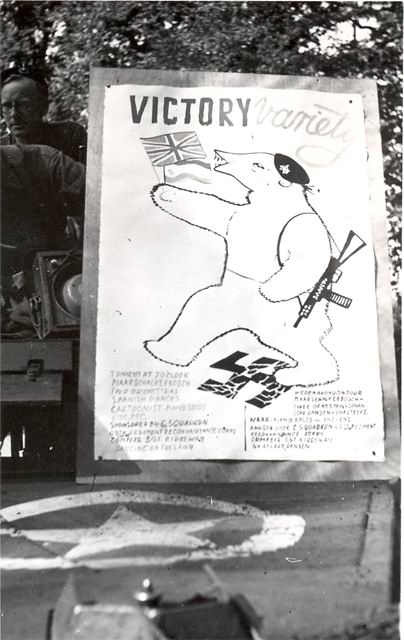
Billboard from the
British 49th. Infantry
Division "Victory Variety" show where these
photographs were taken and where two bands played
(the Canadian North Nova’s and the Scots
Fusiliers from the 49th.Div or “Polar Bears”),
with text in two languages, reading:
Tonight 7 o'clock Maarschalkerbosch:
- Two orchestra's,
-
Spanish dances
-
Cartoonist, piano solo's
etc., etc.
Sponsored by C Squadron, 49th. regiment
reconnaisance corps
Compere Sgt. Ridgeway
- Dancing on the lawn
In his letter (of
Feb 1/1991)
Robert MacBeth wrote to us:
- I have a photo of the band taken the same day as these 2. Will
send later (shown below here). Am in the
process of lining things up. That is me on the right of the
picture (see the first photograph, above here).
Next to me is the only one living, just retired as a
Presbyterian Minister. I guess it is because we were probably
among the younger of the pipers.
- On the uniform the North Nova’s wore the Murray of Atholl
tartan. Everything else was as for the Black Watch except cap-
and collar-badges. Some units carried the hair sporran. We did
not. In fact many times on massed band wore no sporran. When
we did not wear the plain army green hose tops, we wore Murray
of Tullybardine Hose Tops and Murray of Atholl Kilt.
-
Talking of
reeds, for my part I use Henderson reeds mainly, they seem to
have the older tone which we seem to like. A man gave me a
Warnock, didn’t like it at first but turned out very well with a
bit of work, also a couple of McAllister. Yesterday I got two
new from U.S.A. Appear very well made, once I have worked them
over will let you know. I prefer heavy reeds, work them down to
light to suit me. Better than buying. It takes time but I have
plenty of that. The straight commercial are becoming a crude
lot. Canadian reed-makers I don’t think up to par. Takes a lot
of experience to develop. I am very interested in the U.S.A.
ones I have just received.
-
As
you mentioned, considerable difference in setting pipes for
bands or for solo. I have little use for bands, the sound of the
drum within 10 km. of a set of pipes is too close for me. As you
can see, I am 100% traditional. As far as so many of the new
fangled tunes, if you can’t whistle them, don’t play them. Most
of them will not be around very long.
- I called
the Campbell pipe makers. Their pipes are nylon, I am still a
wood man. Will be always. Very good friends of mine. Nice
people. I still feel Robertson chanters were possibly the
best made, at least for me.
-
The
original N.N.S.H members left alive in Nova Scotia right now are
just Duncan MacIntyre, Donald MacLeod and Donald Cooper.
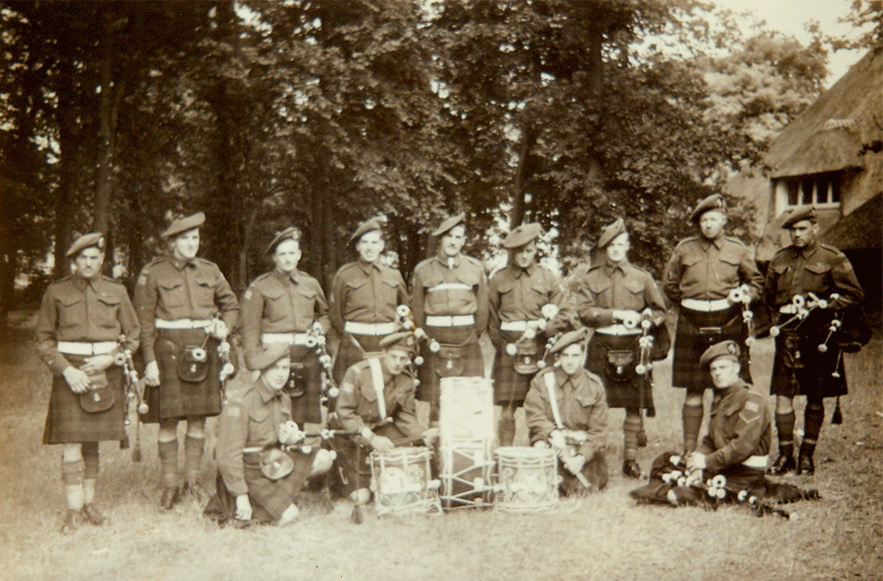
Left to
Right, Back row: P.M. Ross Stone, Joe Beaton, Donald
Cooper, Grant Muir, Russel Yorston, Hugh MacIntyre,
Harry MacLellan, Donald MacLeod, Elmer Farrel.
Left to Right,
Front
row: Robert MacBeth, Peter Dominique, C.C. Cottenden,
L.Cpl.Duncan MacIntyre.
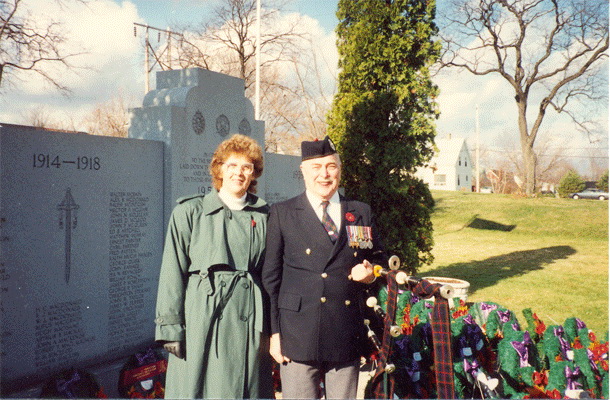

Tera &
Robert MacBeth, and Robert MacBeth at the memorial on Armistice Day,
November 11 1989.
Below Here
are some more remarks of interest from the letters written to us by
Robert:
- As I
was saying, on our trip in 1990 we had a wonderful time in
Holland. It has sure changed since wartime. As everywhere. The
only place that I recognized was the crossroads in the village
of Holten which is now close to the cemetery. We were on the
move coming back to some place near Deventer. We were held up
there a long time. The whole 4th. Canadian Armoured Division
passed, they had priority anyway. Our division #3 took off
north.
- When
they took a town they sent us in, to play up and down the
streets, many places, Leeuwarden (*see
photo of this below here), Dokkum, Groningen, Winschoten.
We ended up at Norden, Germany. We were in Baarn 2 or 3 times
for short spells.
- The
Dutch people just went extremely exited any place we were,
almost unbelievable. The North Nova’s & the other pipe bands of
the 3 Div. were usually massed on these trips. Whatever, quite
an experience, will not forget!
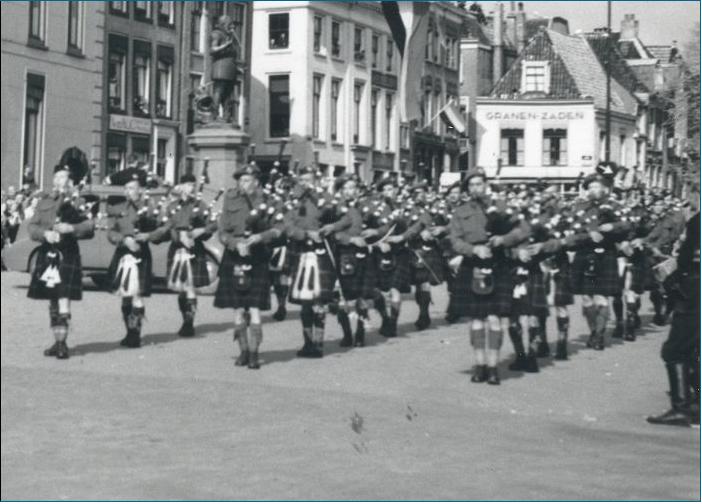
*April
16, 1945: The combined pipe bands of the Canadian H.L.I.
and the North Nova's play after the liberation of the
city of Leeuwarden, (the capital of the
Dutch province of Friesland) by the 3rd. Canadian
Infantry Division. Front Row, left to right: Leading
Pipe major Corstorphine
(H.L.I.) wearing
a 5 (3 plus 2 on top) short white tasseled black sporran, Pipe
Corporal
Duncan MacIntyre (N.N.S.) wearing a
leather sporran, Pipe major Ross Stone (N.N.S.)
wearing a leather sporran like all the
other N.N.S. pipers and drummers. Behind him, in
the second row, the H.L.I. of Canada's Pipe
Corporal wearing a 3 short white tasselled
black sporran, all other H.L.I. pipers wore white
horsehair sporrs with 2 long black tassels.
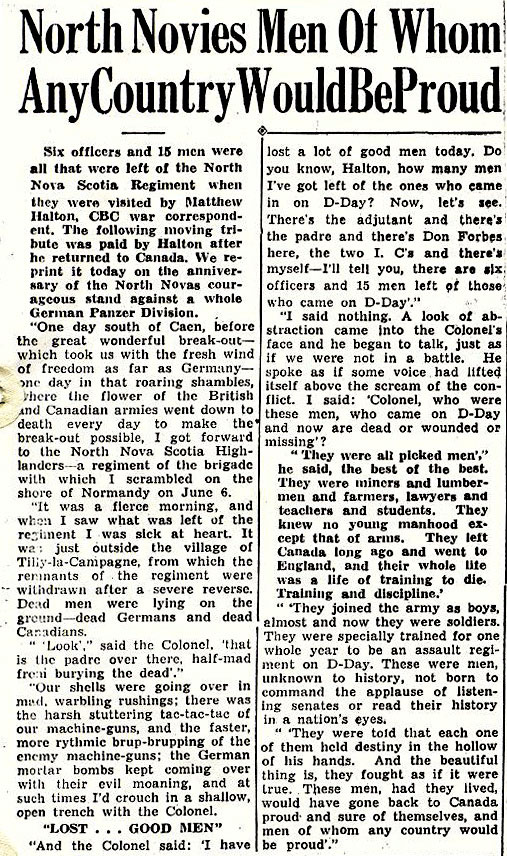
This
reprinted article from the Montreal Standard, originally from directly after the
Normandy invasion illustrated how many casualties, in the
beginning also including from the Pipes & Drums as stretcher
bearers, were suffered by the North Nova's. Replacements for
trained pipers were hard to find. . .
-
There were 4 pipers of the original pipers that left Canada
in 1941 still there at the end. The rest of us were
reinforcements at different periods, mostly in Holland when
the army was based in the Nijmegen area late ’44, first time
they got settled down. I myself was an armourer in the
ordnance corps, nice soft job in England until drafted to
the North Nova’s, having had a bit of piping before I joined
the army, I was very glad I had it, much better in war pipes
instead of machine gun, safer too.
- In
the old system the pipers were trained stretcher bearers,
but from invasion time the regular company bearers took
over. Much of the piper’s work depended on the commanding
officer. Some were rough on pipers, others though otherwise.
Some pipe bands were cut down quite heavily, a couple never
recovered fully. Sometimes I think orders came from on high
to give us a break, so after that we had it quite good. 38
men went thru the Nova pipe band during the war.
- The
repertoire of the pipe band was basically Books 1 & 2 Army
Manual, plus a few out of Willie Ross, I think 1 & 2 was all
of the books out then. The manuals had the drum beats in
them.
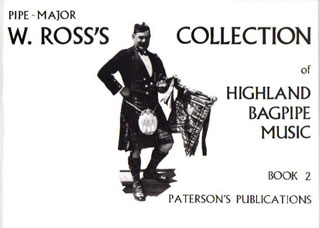
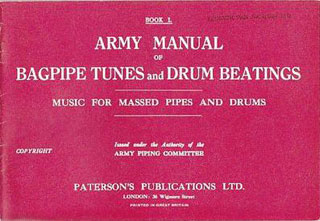
- The
older pipers had mostly been to the school at Edinburgh
Castle, during their long stay in England. That pretty well
stopped in Europe, so I missed that.
- We
all as a whole played issue pipes: mostly Henderson’s,
Lawrie, lower pitch chanters of those years, more volume
than today’s setup. I still prefer that & I still use the
lower pitch . Drones take long tongue reeds. Much deeper
tone & volume. Bridle on the tenor 2" to 21/8"
tongue length.
-
I am
basically a solo piper, I despise the sound of a drum within
a mile of a set of pipes, so you can see I am definitely not
a band man. Play in older style than the new & fast pace
used today.
- When
we formed up in massed band, we just fell in – no particular
order, so in your photo’s (of The Hague Victory Parade)
could be anywhere.
-
Whatever all the best to you & family, if health stays good,
will see you 1995 on the 50th anniversary. As
ever,
Bob MacBeth.
From a 1945 Newspaper Article
about Pipe Major Stone building up the North Nova Scotia
Highlanders pipeband anew
after it having been decimated by the Normandy invasion and
campaign:

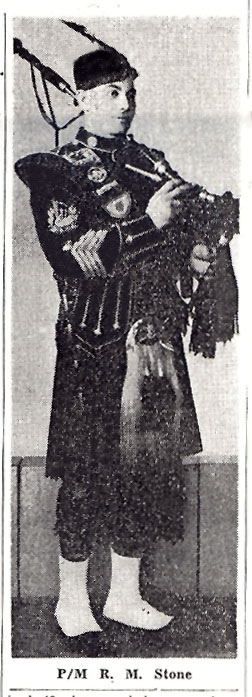
- TAKES NEW LEASE ON LIFE IN HOLLAND -
Truro Man Re-moulds "'Bush Exiled" Pipe Band
By SGT. JIM BOWES (Maple Leaf Staff Writer)
WITH THIRD CANADIAN DIVISION-
There are some soulless citizens who maintain that the bush
is the only place for a pipe band. At the risk of causing
gnashing of teeth and beating of gums in their ranks, let it
be recorded that the pipe band of the North Nova Scotia
Regiment refused to be confined to the bush - and actually
took a new lease on life in Holland. For weeks, while the
unit was stationed in bush country near New Millingen,
Holland, the eerie notes of Scottish refrains echoed through
the forest as Pipe Major R. M. Stone, Truro, worked
patiently to mould a new pipe band. (P.M.
Stone is the son of Mrs. W. C. Mills, Shubenacadie, and his
wife and daughter, Barbara Ann. live in Truro) .
Filling holes left in the band by casualties and
repatriation drafts, Stone combed holding units, hospitals
and the battalion for untried replacements, trotted them off
to the bush, and a month later came back to civilization
with a pipe band. In his sojourn among the trees the pipe
major, oldest member of the regiment left on the continent,
trained an entirely new drum section of seven and eliminated
the wheezes of "salvaged" pipers, who were a little on the
rusty side.
On the Road
Since the kilties swished down the street for the first time
after their return from "exile", they have been on the road
constantly in Germany, Holland and Belgium. When "at home"
the band turns out nightly at battalion headquarters for
Retreat. Their evening appearances have caused so many
traffic jams on the nearby Utrecht-Zeist highway that extra
provosts have been detailed to handle the crowds.
The veteran pipe major has had many proofs of the power of
his pipes and drums, but none quite so convincing as the
request of a Dutch father-to-be that the band be on hand to
greet his wife when she walked out of hospital with her
new-born.
Stone claims more men have passed through his band than any
other pipe band in the Canadian Army. Since the unit was
mobilized, 48 pipers and drummers have come and gone.
Not a few were lost in action - three
days after D - Day. the band of 14 had been reduced to four
men. Equipped with a new set of drums, and outfitted
in new kilts, the band is readying for the biggest
engagement of them all - the parade down the main street of
Amherst, N.S.
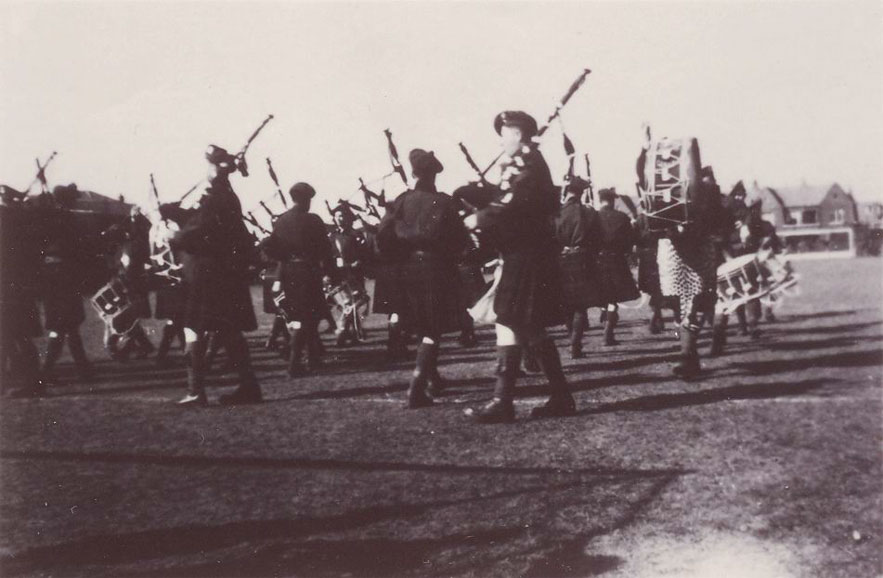
The
North Nova Scotia Highlanders pipe band at Maple Leaf Stadion – Nijmegen 1945.
(Photograph courtesy of Drs. H.M.A. Koenders)
There are
some images from youth that a person will carry with
himself for a whole lifetime.
(see the photograph above)
Drs. H.M.A. Koenders,
who was a boy of about 9 years old at the time, mid
1945, still saw the pipe band walk on the Hazekampse
weg in Nijmegen, and told:
“I can still see them in
my mind’s eye; they made a lasting impression on me.
From that moment on my interest in the Scots was
aroused.”
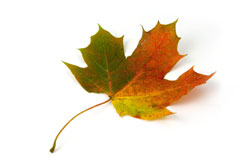
 |